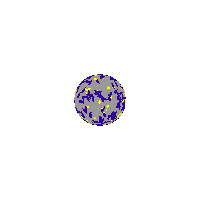Dear Science community,
The universe appears to only have 3 dimensions, yet relativity says it is 4 dimensional. (With time on the same footing as space.) Moreover it is expanding and we are told it has no center. How are we to visualize all of this?
It turns out if you find a good graduate level cosmology textbook, like Weinberg 2007, you will find that you derive the geometry of the universe starting with a normal sphere. (Think surface of a balloon to make sure we are on the same page.) You then generalize this sphere to having four dimensions, consistent with Einstein's equations, and find that this new "generalized" sphere models our universe exceptionally well. In fact, this geometry is the only one consistent with isotropy and homogeneity, things I will blog about later.
Therefore, in a very real sense you should visualize our universe as the surface of a "generalized", higher dimensional, balloon or sphere.
Pretend we were 2 dimensional creatures living on the surface of a normal balloon. Even though the balloon fills a 3 dimensional space, we on the surface would only view it as 2 dimensional. If the balloon expands, what would we see? We would see exactly what the picture describes below:
As time marches on, all the other 2-D galaxies would be moving away from us. Where would the center of our universe be? There is no center of the surface of a balloon.
The same goes for us. Though spacetime is a 4 dimensional object, we being trapped on the surface of this "generalized" balloon means that we only see three dimensions. Moreover there is no center of the universe any more than there is a center to the surface of a balloon. (The Big Bang could be viewed as the center. I'll let you think about that.) And lastly, galaxies moving away from us is mostly due to the space between us expanding, not their actual velocities. (Dots on a balloon move away from each other as the balloon expands even though they themselves aren't moving.)
Now, notice I keep saying "generalized". That is very important. A normal balloon surface, or 2-sphere to be technical, only has one type of curvature. In higher dimensions a "3-sphere", like what we have, can be generalized to have 3 types of curvatures consistent with Einstein's equations that give rise to an open, closed and flat universe. (More on this later.)
Okay, hopefully that solves a lot of visualization problems. Please ask questions!

I like this exampke better than the expanding rasin bread dough. First thing I thought of was the notion of a horizon past which we cannot see.
ReplyDeleteYes, I like this analogy better too. Furthermore, as I suggested, I am convinced that it is more physically accurate. You really can get the FRW metric starting with that of a sphere and generalizing. I know of no way to get the FRW metric from modeling rising bread.
ReplyDeleteIt's because you don't have the right kind of bread pan. Proper cooking tools will yield the correct metric everytime! ;)
ReplyDeleteOh man, that's where I've gone wrong, I completely forgot to factor in the right kind of pan!
ReplyDeleteJared, I expect a post from you one day about life on a general p-brane. :)
Whoa.
ReplyDelete/Keanu Reeves
I see why my previous question about Hubble's law was nonsensical given this model. Thanks for the post!
Mephibosheth, it was a good question and very commonly asked. The more such questions I get the more I know to post about.
ReplyDeletewhat's wrong with the idea of eternal universe? it is the same as compacting billions of billions .....of billions of tonnes mass in a tiny dot to allow "big bang"
ReplyDeleteobserver, I agree that there is nothing wrong with it. I just hope it turns out to be true.
ReplyDelete